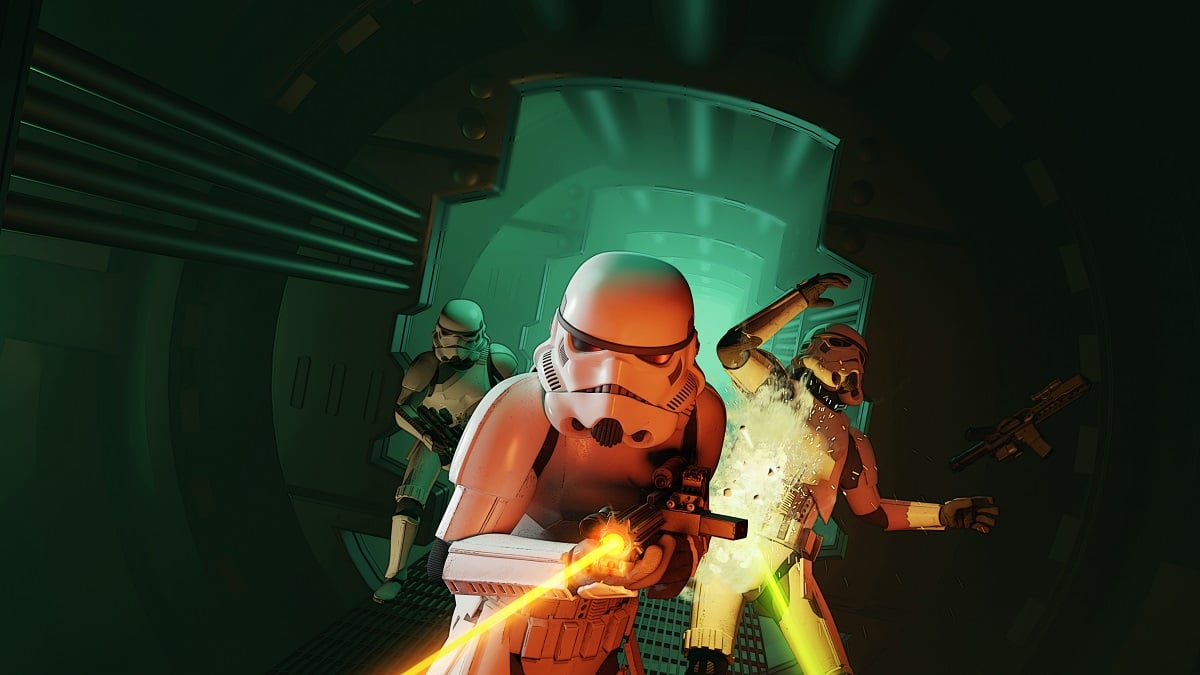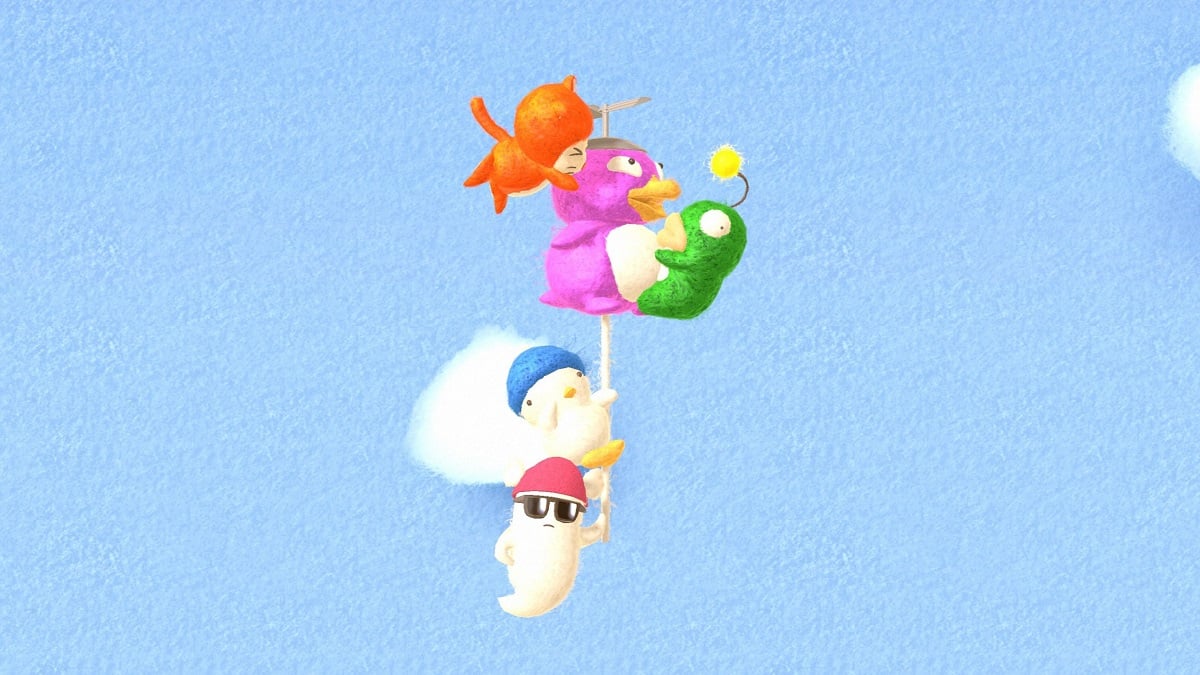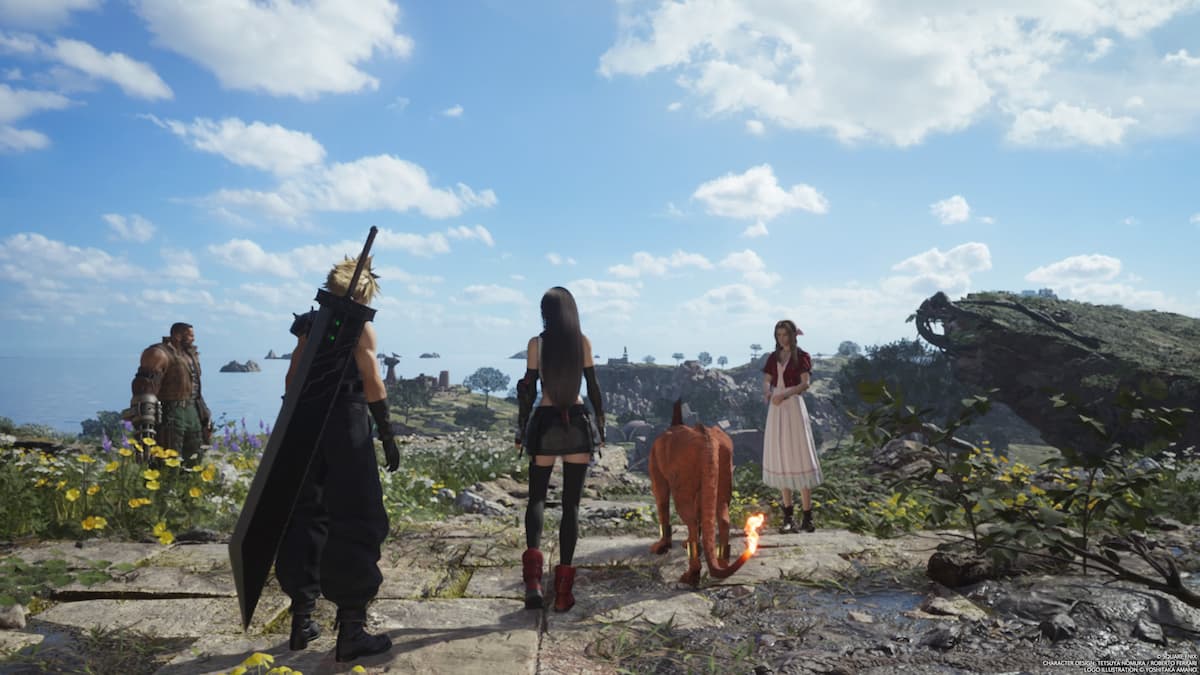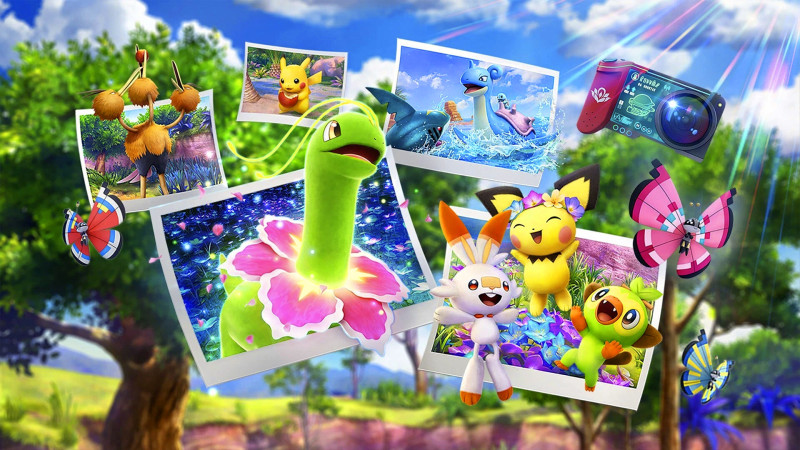
With Pokémon Red & Blue and the anime less than a year old in the U.S., 1999’s Pokémon Snap on Nintendo 64 let players step into a completely new role in the Pokémon world. Rather than traveling across the land, searching far and wide for Pokémon to catch, train, and battle, players instead moved behind the camera lens in an experience that brought the world of Pokémon to life in ways that were, to that point, unprecedented. Now, more than two decades later, Pokémon Snap is finally getting a follow up on Switch. Separated by 22 years and three full console generations, New Pokémon Snap looks to retain the spirit of the original while adding new folds to the formula. I had a chance to watch extended demos and speak to the director, Haruki Suzaki, to see how this new game evolves the 1999 cult classic.

Capturing Pokémon’s Good Side
By 2021, we’ve experienced the Pokémon universe from so many angles that I wondered if the Pokémon Snap formula would still feel novel. However, following my time with the game, I’m once again excited to pick up the camera. Just like in the original, you assume the role of an enthusiastic photographer who travels on predetermined paths through various environments snapping photographs of Pokémon in their natural habitats.
Keeping that basic formula was important to the development team at Bandai Namco Studios. Rather than reinventing the wheel, the team instead looked for ways to modernize, adjust, and enhance. “I absolutely wanted to keep the foundation of the base gameplay where everyone can have fun just looking at Pokémon thriving in nature and taking snapshots of them,” Suzaki says.
Suzaki has worked at Bandai Namco since 2002 and served as director of the company’s Pokémon fighting game, Pokkén Tournament. That game debuted in arcades and Wii U, but has since made its way to Switch. Because of this, Suzaki has a keen appreciation of not only the Pokémon franchise, but also how the Switch can enhance preexisting games or series. With New Pokémon Snap, Suzaki wants to deliver on the potential of the Switch hardware, giving players lush, beautiful environments to move through as they take photos of their favorite creatures.

Of course, a lot has changed for the Pokémon franchise since 1999; not only have trainers expanded their horizons far beyond Kanto, but the Pokédex has exploded from the original 151 entries to the nearly 900 that exist today. While Sword & Shield did not include every Pokémon, which remains a controversial topic, that subject is more palatable when it comes to spin-off games like Snap.
According to Suzaki, the theme of photographing Pokémon in their natural habitats served as the team’s guide. “The selection of Pokémon was truly hard,” he says. “My vision was to create a world where you can actually imagine wild Pokémon thriving in their natural habitats and ecosystem. At first, we thought about Pokémon’s natural habitats and fascinating landscapes and climates to research. Then, we narrowed down our choices by balancing out how different Pokémon would live in these habitats and their relationships within each environment. As a result, there are more than 200 Pokémon, rich in variety, appearing in this game.”
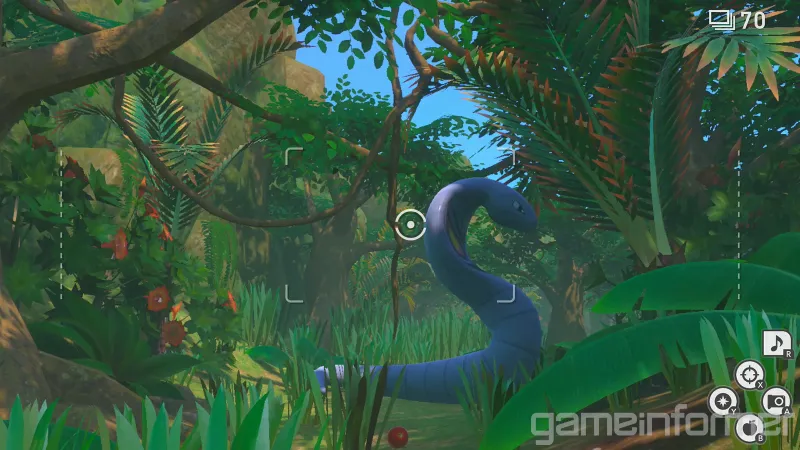
A Ride on the Wild Side
In an exclusive look at the Founja Jungle stage in New Pokémon Snap, I see firsthand what Suzaki means when he talks about creating beautiful habitats full of Pokémon that make sense for the locale; you can almost feel the humidity of the jungle stage from the jump. While you must work to get the attention of certain Pokémon, the opportunities to see your favorite creatures throughout the game’s Lental region are plentiful.
Whether you’re talking a group of Bounsweet relaxing on an overhead branch, a Pikipek hammering away at a tree, or an Arbok behind the brush, you have several different creatures to focus on and try to interact with using fluffruit or other means. Tossing a fluffruit, which resembles an apple, in the direction of Pokémon can elicit different reactions from creatures. While the most common reaction is happily chasing it down to munch on, the reactions vary by Pokémon. For example, one Liepard, in true cat fashion, completely ignores the fluffruit in favor of continuing its nap.
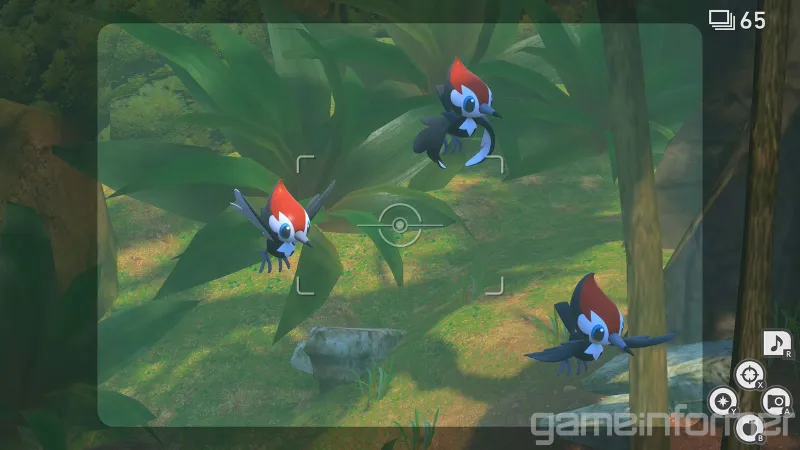
In addition to fluffruit, players have other tools at their disposal. Scan allows you to not only see if something is hiding beyond your view, but also garner a reaction from some Pokémon. You can use the Melody tool to see if the Pokémon feel like dancing. New Pokémon Snap also introduces Illumina orbs, which can trigger unique behavior and cause Pokémon to glow.
The key to getting the best shots is to keep your eyes peeled and get creative with how you use the tools. “These are simple things, but a combination of these tools, timing, and situations can cause a variety of things to happen,” Suzaki says.
Not all Pokémon need to be incentivized, however. Throughout Founja Jungle, Beautifly curiously flutter right up to you, giving you several chances to snap them both alone and in swarms. Later in the stage, you’re given a scenic waterfall with a pool surrounded by species including Magikarp, Quagsire, and more. I wonder if there’s some way to push that Magikarp into the waterfall, but I unfortunately don’t get the opportunity as my look at this stage ends.
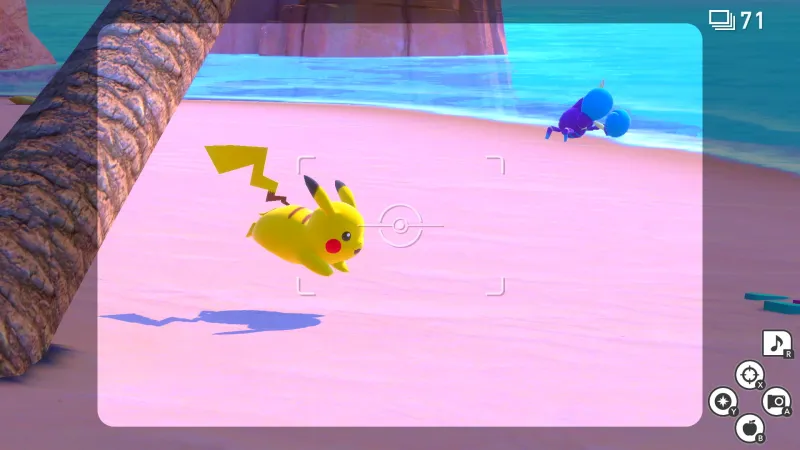
Seaside Snapshot
In addition to Founja Jungle, I’m treated to multiple playthroughs of an early tropical level called Blushing Beach. As players travel to different islands in the Lental region, they explore vastly different biomes, even diving beneath the ocean’s surface in some cases. Sadly, I don’t get to see the secrets hiding under the waves in Blushing Beach, but I do get a great sense for what to expect from this sandy stage depending on when you visit.
The first playthrough of Blushing Beach I see takes place during the day. Right off the bat, I spot a couple of Exeggutor frolicking across the sand as a Crabrawler scurries along. A Lapras swims in the shallows and a Pikachu playfully runs past. In the distance, I spot Vivillon and Wingull soaring over the sea. Immediately I recall the fond memories I have of the Nintendo 64 original. That scene, with Exeggutor basking in the sun while other Pokémon go about their days, takes me back to the first stage of the original Pokémon Snap, where a flock of Pidgey fly toward the camera before you see Pikachu, Doduo, and Butterfree hanging out on the beach.
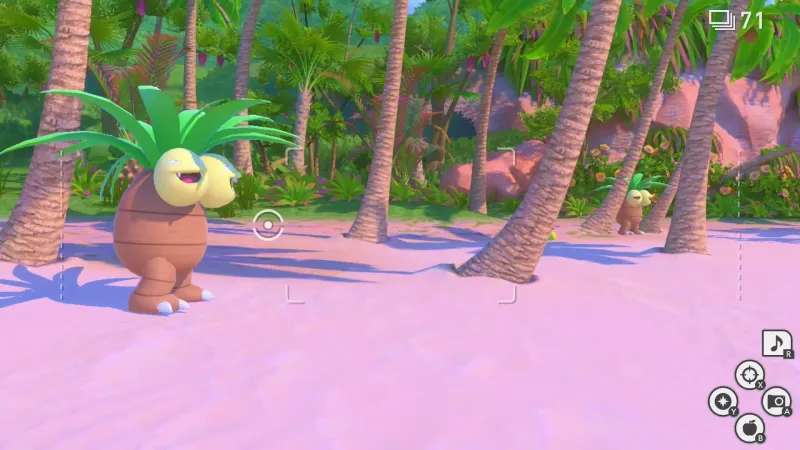
We toss the Exeggutor a fluffruit and it joyfully scoops it up as we snap away. We continue along the beach, but another Exeggutor sits in the way, bringing our NEO-ONE pod to a halt. We could lure the big guy away to clear the path, but instead we look to our left and notice something is bustling in the bushes. We scan to reveal that some Bellossom are tucked away. As Suzaki says, it’s up to the player to figure out how to lure Pokémon to you and get them to react. In this case, we use the Melody tool to bring two dancing Bellossom out of the bushes. As players of the original game know, if you can snap multiple Pokémon in the act of doing something unique or exciting, you’re well on your way to getting a highly scored photo.
Now that we’ve gotten some great shots of Bellossom, it’s time to move on. We throw a fluffruit and pull the Exeggutor off the path so we can continue. While you can’t manually stop your vehicle whenever you want, certain encounters like this one give you a little extra time to figure out how to optimize your opportunities.
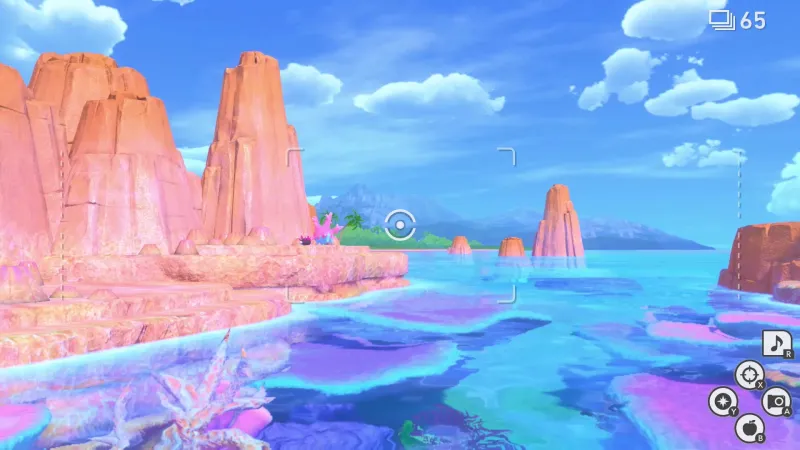
Continuing down the path, the pod leaves solid ground to float among the waves. Weaving between rocks that jut out of the sea, we have a wealth of opportunities presented to us. Do we photograph the Machamp hanging out on shore or do we focus on the Pyukumuku lounging on the rock next to Corsola? We end up scanning two water-types on the rock, causing Pyukumuku to wave at us and Corsola to flash a smile our way.
Finneon swim beneath us as we head back to shore. This trip through Blushing Beach is just about over, but not before we spot a Stunfisk lying flat on the sand. We shoot a picture of it and then head straight for the goal, exiting the daytime run of Blushing Beach.
Click image thumbnails to view larger version
Holding a Mirror to Your Work
After completing each stage, you select the photos you want to share with Professor Mirror. Each shot is given a rating up to four stars. This is important, as your Photodex can hold one photo of each Pokémon at each rating. Once you present your favorite shots to the professor, he’ll score them based on pose, size, direction, placement, other Pokémon in the shot, and what the background looks like. You then have the option to replace the current picture in the Photodex with the new one.
If you feel you could make your shots a bit better with some tweaking, New Pokémon Snap gives you the tools to perfect them. Seemingly inspired by the Instagram age, New Pokémon Snap allows you to “re-snap” your photos by adjusting the zoom and tweaking the brightness, blur, focal size, and focal point. You can add a filter and even stickers to create comical or cute scenes within your shots. Unfortunately, Professor Mirror will only grade your raw photos, and thus, you can only save the originals to your Photodex. Don’t worry, though, as you can still save the re-snapped photos to your in-game album and share them with the world online.

Based on the photos you provide to the professor, you gain expedition points, which boost your research level for the stage. Once you reach a certain threshold, you unlock new levels for that area and time of day.
“Pokémon behavior will change as the research level increases,” Suzaki says. “A new research will start when your level increases to search for the changed behavior and photograph it. The game is also about trying to take a photo of a great moment you missed in the next trip, so if the research level is the same, the research course stays the same in general. But if the research level goes up, you will see many changes such as Pokémon that didn’t appear before will start appearing, Pokémon that didn’t eat fluffruit because they were being cautious will now eat them, and the pod’s course will also change.”

Nocturnal Negatives
After chatting with Professor Mirror and further filling out the Photodex, we jump back into Blushing Beach. However, this time, we’re going after the sun sets. As you might expect, the Pokémon you spot at night are often different from the ones you see during the day. Even as the character is entering the environment, I spot a Drifblim in the background and a towering Zangoose walks along the path. We throw the Zangoose a fluffruit and get a great shot of of it smiling as it enjoys it.
As we approach the bush where the Bellossom were during the day, we once again scan the area. The tool tells us something sounds like it’s sharpening a blade. This time, we’re not graced by the playful twirling of the smiling grass-types; instead, a fierce Seviper emerges just in time for a photo. It’s a good thing we scanned early on, as there’s no Exeggutor to block the path at night.

The night path is the same as the one we traversed in the sunlight, but your opportunities are vastly different. As soon as we go out onto the water, Inkay floats by and we see a Magikarp asleep on the rock where the Pyukumuku was during the day. We could snap a photo of the sleeping Magikarp, but what’s the fun in that? Scanning does little to wake up the sleeping splasher, but by tossing an Illumina orb at it, the Magikarp springs to life, and flips off the rock and into the water. We capture its acrobatics before moving to the next rock.
This evening expedition presents an Octillery perching on the rock next to a Crystabloom plant. We throw an Illumina orb at the Crystabloom and the octopod reacts by spitting a fountain of ink straight into the sky. We snap a photo, then throw a fluffruit at it and the Pokémon waves at us with one of its arms. As we continue to survey our surroundings, I spot a Bellossom and a Zangoose relaxing on the shore, but just above them, a Mareanie looks down off the cliffside, presenting a new Pokémon for us to photograph; we don’t waste the opportunity.

While we’re out at sea, an icon pops up in between some of the protruding rocks. If you scan that, you’re able to go along a different path through the stage. However, to fully explore how different night and day versions of stages really are, we opt to stay on the main path.
We return to land to perhaps the most exciting opportunity of my entire demo: Several Sandygast lay hidden beneath the beach, while an Alolan Raichu sleeps on shore next to a chill Octillery. We toss a fluffruit at the Sandygast to get it to emerge. As we pass by, the Raichu awakens, hops on its surfboard-shaped tail, and rides out into the waves. Just before we reach the goal, we lob a fluffruit at a Sandygast next to the Octillery. When the creepy sandcastle Pokémon emerges, it gives Octillery a huge fright and the water-type Pokémon panics, fleeing out into the middle of the ocean, arms a-flailing.
This hilarious scene is just an example of how players can not only evoke interesting reactions, but exciting interactions between multiple Pokémon in the habitat. The environmental puzzles of New Pokémon Snap appear to be just as much fun as they were in the original. Shortly after that, my nighttime run ends, as does my time with New Pokémon Snap.
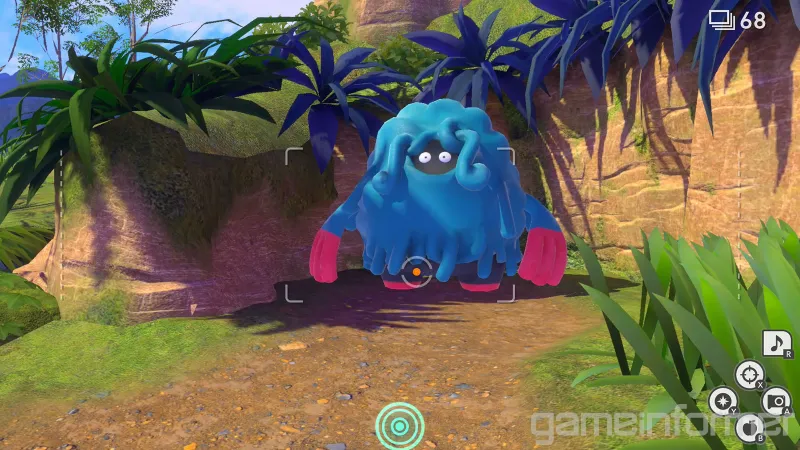
Developing Results
If what I saw is any indication, New Pokémon Snap effectively captures the magic of the original. With a new region, new mechanics, and a vastly expanded collection of Pokémon to pull from, I’m excited to see how this entry improves upon the first game. More importantly, I can’t wait to get back behind the lens and document the fascinating sights for all to see when the game is released at the end of this month.
This article originally appeared in Issue 335 of Game Informer. Portions of this article previously appeared here as part of a prior embargo.

